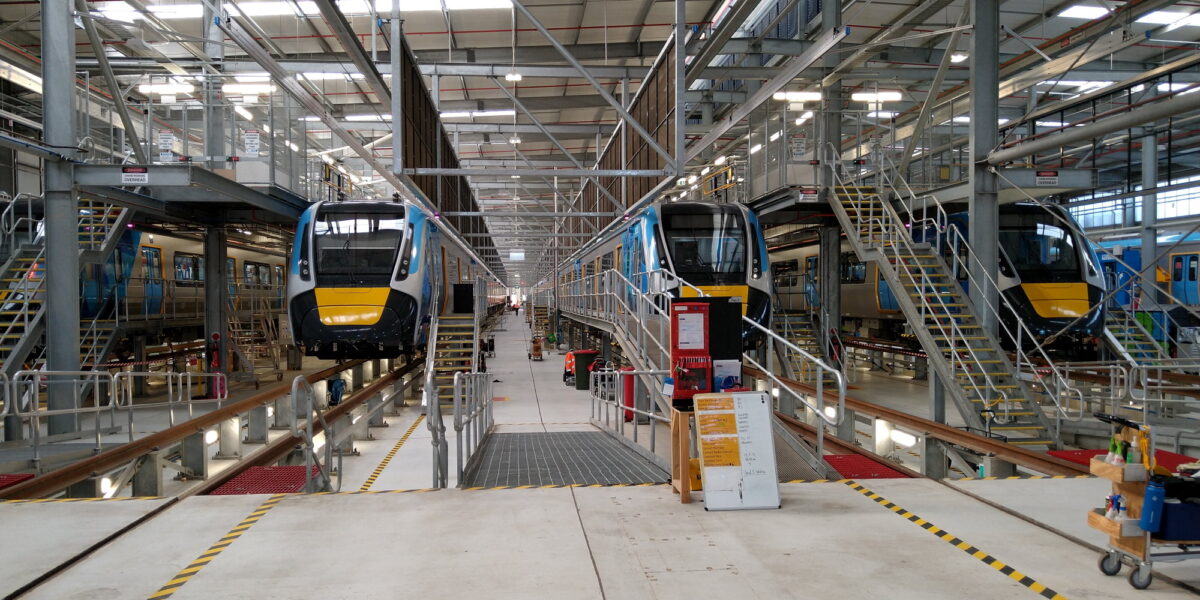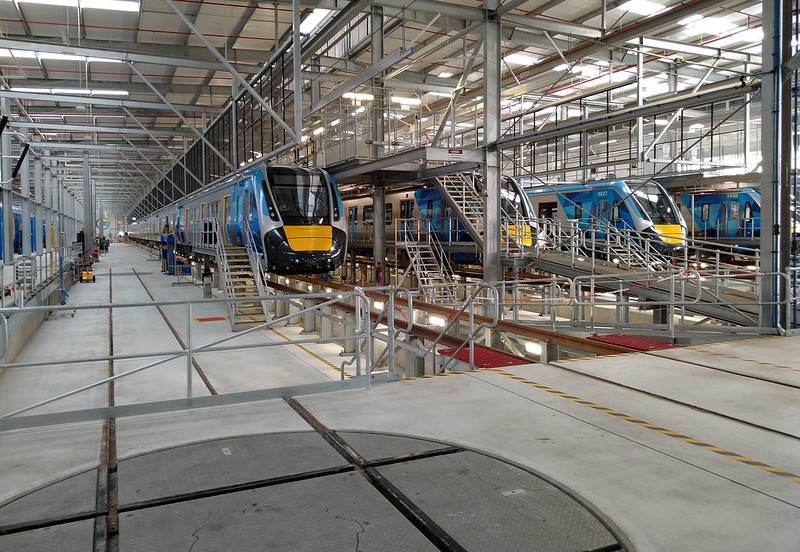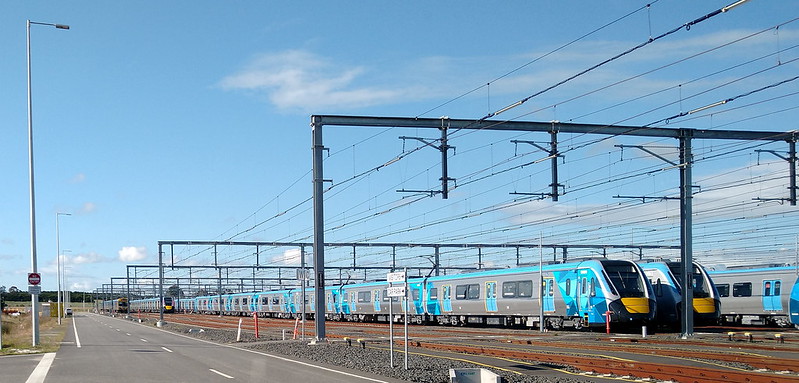Last week, before lockdown started, I got to look around the Pakenham East train depot, courtesy of Evolution Rail – which is the company introducing the High Capacity Metro Trains onto the rail network.
(My personal view is that HCMT is a terrible name for a train. Some people are calling them Evolution trains, and I’m going with that.)
Evolution is a consortium that includes Plenary, Downer, Chinese rail manufacturer CRRC and others. They have a contract to manage the introduction and maintenance of the trains for 30 years.
The train shells arrive from China and are fitted out at Newport before being sent to the depot (technically the TMF – Train Maintenance Facility), which is a few kilometres past the end of the Pakenham line. You can see it on the Google Maps aerial view – a wedge of land about 2km long which includes a loop test track around the eastern end.
Metro Train services will be extended to closer to the depot, with a new Pakenham East station, which will also serve nearby housing. This will allow them to rebuild Pakenham as an elevated station above the road, without complicated stabling and V/Line passing tracks, to remove the level crossing there.
After signing-in and doing an alcohol test (they’re clearly very serious about security and safety) I got to go into the facility. Full PPE is required in most areas.
There’s extensive stabling for the trains themselves. Only a handful are currently in service, but more are being commissioned all the time, and Evolution says that some delays early on, things are now going smoothly.
On site they have all the facilities for light and heavy maintenance of the trains. This includes tasks such as changing wheel bogies – with little turntables to help move them around. They’ve got storage for an extensive array of spare parts – it’s like looking at someone’s immaculately sorted Lego collection.
They’ve got a wheel lathe on-site, though it may be a little while until it’s needed.
The TMF is set up to handle trains of 6, 7 or 10 cars. Currently the new fleet is 7 cars (Cranbourne/Pakenham line platforms have been extended to cope with this), but they could in future run as 6, which would theoretically mean they could run anywhere on the network (though other upgrades such as power might be required).
The catch is that while a 7 car Evolution train has about as many seats as the 6 car trains in the rest of the Melbourne fleet, a 6 car Evolution train would have fewer, at least in the current configuration.
The metro tunnel is being built to cope with 10 car trains, and at some stage they will extend existing platforms to fit them too, to boost capacity further.
I didn’t get a close look, but in one area they’re also testing Platform Screen Doors, which will be a feature in the new underground stations.
They have simulators to train up Metro drivers on the new fleet – a mix of basic simulators set up in a classroom arrangement, and also a full size mock-up cab.
I was told that until now, the Evolution trains had run in service with two staff in the cab as part of their introduction. From this week, it’s one driver in the cab.
Drivers can call for assistance with possible faults, with diagnostic tools used by the staff at Pakenham East to be able to help resolve problems remotely in many cases.
Overall it’s an impressive operation. They’ve benefited from being able to build the place on a greenfields site – unlike say Newport or Dandenong or Ballarat where facilities up to 150 years old have evolved over time.
I got the impression that after a rocky start (not unusual for new train fleets) things are running very smoothly. And there’s clearly a big focus on train reliability during the 30 year PPP contract.
Feedback on the new trains from drivers seems good, and from the public too – with one notable exception: door operation, which I quizzed them about. There was a known issue with a long delay seen when you hold down the door button as the train comes to a stop – quite confusing for passengers, in part because the Siemens trains also (also used on this line) will open the doors.
The long delay was a software glitch which is now fixed. But as a safety measure (conforming to modern standards), you will need to take your hand off the button – just for a moment – and press it again to make the doors open.
With Melbourne currently in lockdown, most of us aren’t travelling right now, but more Evolution trains will be out on the network in coming months, and will be a welcome sight for those who catch them.
Many thanks to Evolution Rail for the tour.










19 replies on “Pakenham East: home of the Evolution trains”
I didn’t see any HCMT trains just before the new year, when apparently they were starting on the network, but I was on one almost 2 weeks ago. The heating was a comfort from the outside cold weather that morning. 🙂
I’ve only been lucky to experience the train once…I loved how quiet and smooth running it was…sadly they won’t be running on my line(Sandringham)
I got a chance to briefly ride the new Evolution for the first time recently and I have to say they are great looking trains! Being able to walk from the first carriage to the last was very cool. I also ran into the issue with the door button, thankfully I was aware of it because of you, but it’s going to confuse a lot of passengers once things pick up again.
I had my third ride on Thursday of last week. Literally on the eve of Lockdown 5.0
I have found them to be a good ride.
I dont like the buttons on the doors. I believe they are touch-sensitive, like touch screens on smart-phones. Whereas the Siemens and Xtraps are a button you push in.
The reasons why I dont like this is, it only works if you use a bare finger. You cant use a glove of various materials as they will not have a static charge to trigger the button. And, there is nothing like the tactile sound and feel of pushing in a button.
I like the passenger information displays. They are a real positive.
There is no real reason why they can not have 7-car trains on other lines, you just need to let the rear doors overhang a bit. Only on terminal locations, and perhaps some signal spacings etc.
Oh, on lockdown-eve, which was the A.R.E. meeting, people where under the impression that, there is some kind of a union ruling or ban on these trains. Perhaps a ban on them ever becoming ‘driverless’?? My sources where not clear on the details.
I thought the original contracts required 5, 7 or 10 car configurations, not 6?
Also, can you elaborate further on the door opening delay requirement? I prefer the Adelaide model where you can request the door at any point between stations and it will open when released by the driver
@Matt, hopefully the fixes will mean passengers aren’t confused with the doors. (I think some or all of the X’Traps work the same way; need to check)
@David, no, I’ve checked the original EOI document (summarised here). The default consist was 7 cars, with options specified for 6 or 10.
I’ll go with Evolution, less ponderous than HCMT.
Do you know if the Evolution has been on test runs on other lines? i don’t think they have.
A thirty year PPP contract for the train sounds very wrong to me.
So you are saying that if you press the door button as the train comes to a stop, the doors will eventually open? Or you have to repress the button? I thought you previously said it would not open at all. I wait until the button lights up before pressing.
David Stossers comment about how Adelaide train doors work sounds like it is best for passengers. That is press the button as a request for the door to open at the next station. Too sensible.
@Andrew, I suspect the reason they don’t open without pressing after release is they don’t want the situation where there’s a packed train, and the doors unexpectedly open from someone leaning on the button, resulting in people falling out onto the platform.
But if they’re touch sensitive, then it wouldn’t register if someone is just leaning against the button. It would require an ungloved finger.
The HCMT project documents specify that each train requires “local passenger-operated door controls in accordance with EN 14752 section 4.3”.
Unfortunately these standards are paywalled, but I’m assuming there is something in there that explains why such a passenger-hostile mode of operation has been implemented.
@Andrew – HCMTs have been out on test runs to Belgrave, Reservoir, Elsternwick, Flemington Racecourse, Werribee and Sunbury.
https://wongm.com/2021/01/tracking-high-capacity-metro-train-rollout/
Gotta say, I’m not sure I agree that requiring the button to be pressed after the train has stopped and the doors have been released is particularly passenger-hostile. It’s different to the Siemens trains certainly, and potentially confusing, but not unreasonable.
I’ll reserve judgement on the buttons themselves until someone actually confirms whether they are touch-sensitive or not.
You should see if you can pull strings to get down to the TMF in Newport! I was lucky enough to go there once for work, calibrating a piece of equipment. A real hive of activity with the cars in all stages of assembly, production-line style.
The “passenger-hostile” bit was the delay that occurred if you pushed the buttons before they were released – glad to see that bit has been fixed!
@Matt, noted, thanks!
@Marcus, yep agreed!
By the way, I checked and the X’Trap I took yesterday does the same thing I’ve seen on the Siemens trains: the door opens if you’re holding down the button when the driver releases it.
Today was the first day that I saw more than one HMCT train in service – one heading outwards towards Pakenham, and then 20 minutes later, another one going inwards at Richmond. (They may have been running multiple trains for a while, but I haven’t seen more than one in such a short time span). Also saw several of them at the Newport Workshops, including some carriages still wrapped in plastic.
[…] trains (including the Evolution/HCMT trains and the yet-to-be-introduced X’Trapolis 2.0 trains) will replace them and expand the overall […]
[…] shiny new Evolution HCMT trains run along the Dandenong line to Cranbourne and Pakenham. There’s now quite a few of them in […]
[…] platforms are long enough to fit 10-car Evolution HCMT trains when they eventually come into service. Platform Screen Doors will be fitted, a first for […]